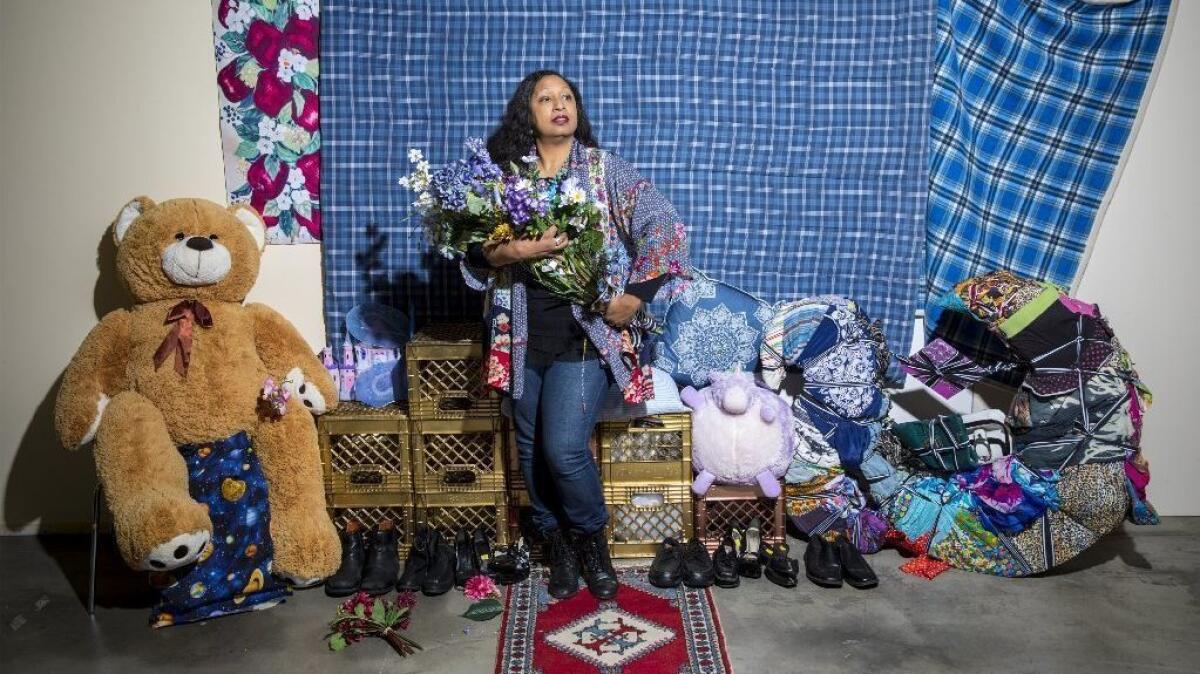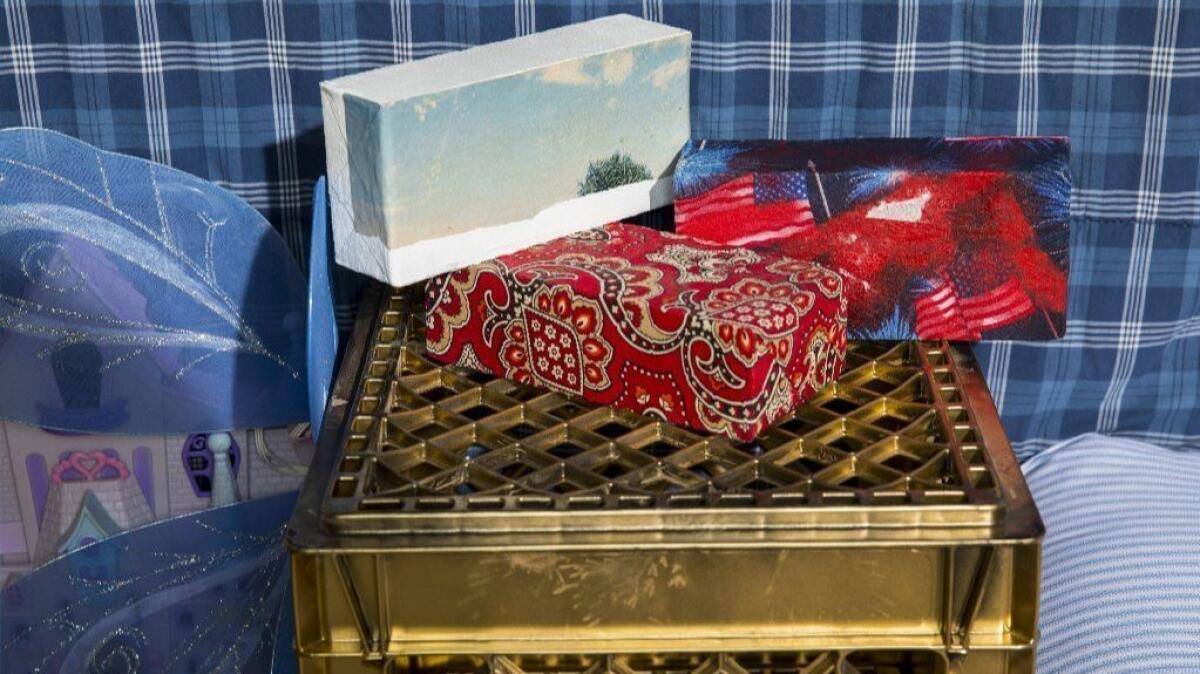Shinique Smith’s ‘Refuge’ explores shelter, homelessness and the excess of our stuff

- Share via
Shinique Smith was filling her car’s gas tank late one night in February when she noticed a vase and a child’s pink, plastic scooter sitting atop a garbage can. As an artist who works with found objects, she rounded up what she assumed to be trash. Then a homeless man living out of his truck emerged, directing her attention to handwritten price tags on the objects. He was selling the goods for gas money.
Smith filled his tank in exchange for the items, then incorporated them into an art installation she was making about homelessness and the exchange of goods flowing through donation centers.
That finished piece, “Donation Center” (2018), is one of several works on view through Sept. 9 in Smith’s solo exhibition “Refuge” at the California African American Museum. The show has theatrical installations, abstract paintings, mixed media wall works and soft sculptures made from recycled clothing, scraps of fabric, personal items and found objects, among other materials.
“Things that were mine, things that belonged to friends and family. Stuff,” Smith says. “Really basic stuff stands out to me. I’m fascinated by the way we feather our nests as creatures. And the way we survive when we don’t have a nest.”
One piece looks at first to be a lumpy pile of fabric and pillows, the mound slumped to the side. But stare long enough and the sculpture, “Mitumba Deity II” (2018), begins to take the shape of a Buddha leaning to its side. Viewers are invited to rest on pillows around it.
Another sculpture, “Bale Variant No. 0021 (Christmas)” (2011-2018), resembles a totem or obelisk composed of folds of fabric, layers of clothing, wrapping paper, Christmas ribbons and rope, with collaged bricks, like tidy holiday presents, scattered on the floor around it.
A domestic-looking installation by the gallery’s entrance, “Love Resides” (2018), is especially dramatic: The floor is covered with uneven carpet remnants, the walls a pastiche of patterned wallpaper, clothing, paint drippings and sprayed graffiti, with a dirty sink featured prominently.

Collectively, the works in the show speak to material accumulation, the comforts and safety of shelter, displacement and homelessness in the U.S. and elsewhere. Dichotomies abound: The art is made from new and used objects that were culled from the artist’s home and the public realm; the work nods equally to excess and lack, to public and private space, to feeling both protected and exposed.
“It’s about belonging, the need to belong,” says Smith, who recently relocated to L.A. from New York, where she still keeps a studio. “I didn’t want to mimic homelessness, but I wanted things to allude to it. My work’s always been about finding a place for things that were discarded and the people who own them.”
Smith has been collecting objects wherever she goes for about 17 years with an eye for color and texture, but also for conceptual through-lines. A variety of kitschy mugs she found in a Christian thrift store all feature uplifting nature scenes and affirmations such as “serenity,” for example. A tissue box, a handful of matchbooks and some peeled-off beer labels feature landscapes and mountain ranges on them.
“They’re ideas of utopia, utopian visions that are embedded into these small objects that I feel drawn to,” Smith says.
The slow, organic, ongoing process of collecting materials for her art is central to Smith’s practice. It’s almost a meditative ritual. Her art studio, in a cavernous Glendale warehouse she shares with another artist, is filled with more than 50 bins on shelves, each stuffed with a single type of object: plastic toys, flattened cans, cups and saucers, ribbon. One holds her grandmother’s linens, another stuffed animals, another rolls of yarn. About 300 additional bins sit in a storage facility around the corner, she says.
Smith started out as a figurative painter before gravitating toward abstraction. To make her sculptures, she bundles the items and binds them with rope, tuxedo ribbon or cotton clothes line. How the piles naturally fall and slouch informs the final shape.
Her massive installation of draped, stuffed and woven fabric coils filled Hauser Wirth & Schimmel’s breezeway connecting 2nd and 3rd streets when the gallery debuted in 2016. Paul Schimmel, who curated the gallery’s inaugural exhibition, “Revolution in the Making: Abstract Sculpture by Women, 1947-2016,” which the Smith piece was part of, called the strands in her work “celebrations for a future and what will take place in, around and through her immersive environments; while simultaneously, they are remembrances of a history, the morning after the intoxicating pleasure of life.”
Smith’s abstract paintings and wall works are a colorful mix of applied paint or ink, collage and assemblage. One particularly dynamic piece, “This Year’s Girl” (2009-2018), is a textural mish-mash of intimate clothing items — a bra, sparkly skirts and scarves, hair ribbon — all stuffed into or hanging from a fence and steel elevator gate adorned with basketball hoops. Behind it, a florid, calligraphy-like graffiti design on the wall appears to be growing out of the artwork, like weeds tangled up in a chain link fence.
Smith also creates mini-installations, or “little surprises” as she refers to them, behind or near some of the artworks. Behind “Mitumba Deity II,” there’s an alleyway-like area lined with washed out, pastel-colored clothing — work attire in a palette that suggests spring fashions, a nearby plaque points out — hanging on a graffiti’d wall, as if laundry drying outdoors. That the alleyway appears behind the Buddha figure, a work that suggests sanctuary, reflection and relaxation, is another dichotomy.
Smith grew up in Baltimore with her mother, a clothing designer and fashion editor. During high school, she was part of an otherwise all-male graffiti crew. Meandering the city’s alleyways, often at night, she tagged walls and witnessed homeless individuals living on the streets, their belongings strewn about. Years later, she applied her love of graffiti writing’s fluid swirls to studying Japanese calligraphy. All of these influences, especially from her mother, factor heavily into her art work.
“We went to fashion shows, I was in and out of fabric stores all the time. I hated the smell of it as a kid, but of course it influenced me,” she says. Of being a graffiti tagger, she says: “I observed the city, and now I observe everywhere in the same way. Also, calligraphy — that line, the linear nature of it — binds together things on the surface of a painting the way ribbon binds together the fabrics and objects in a sculpture.”
Her “Donation Center” is as much a serviceable nook in the exhibition where visitors are invited to leave supplies for homeless families, or cash in a donation box, as it is an evolving installation that grows as donations pile up on shelves.
The gas station vase, however, is now gone. It still had the original price tag on it, and Smith suspects someone walked off with after leaving a few dollars.
“But that’s part of what the space is all about,” Smith says.
“I’m interested in the exchange of stuff. How it changes hands, how it gets abandoned, bought, sold, acquired. And the meanings assigned to it. The vase, it went out into the world.”
♦ ♦ ♦ ♦ ♦ ♦ ♦ ♦ ♦ ♦
Shinique Smith’s ‘Refuge’
Where: California African American Museum, Exposition Park, 600 State Drive, L.A.
When: Through Sept. 9; closed Mondays
Admission: Free
Information: (213) 744-2084, caamuseum.org
Follow me on Twitter: @debvankin
More to Read
The biggest entertainment stories
Get our big stories about Hollywood, film, television, music, arts, culture and more right in your inbox as soon as they publish.
You may occasionally receive promotional content from the Los Angeles Times.











